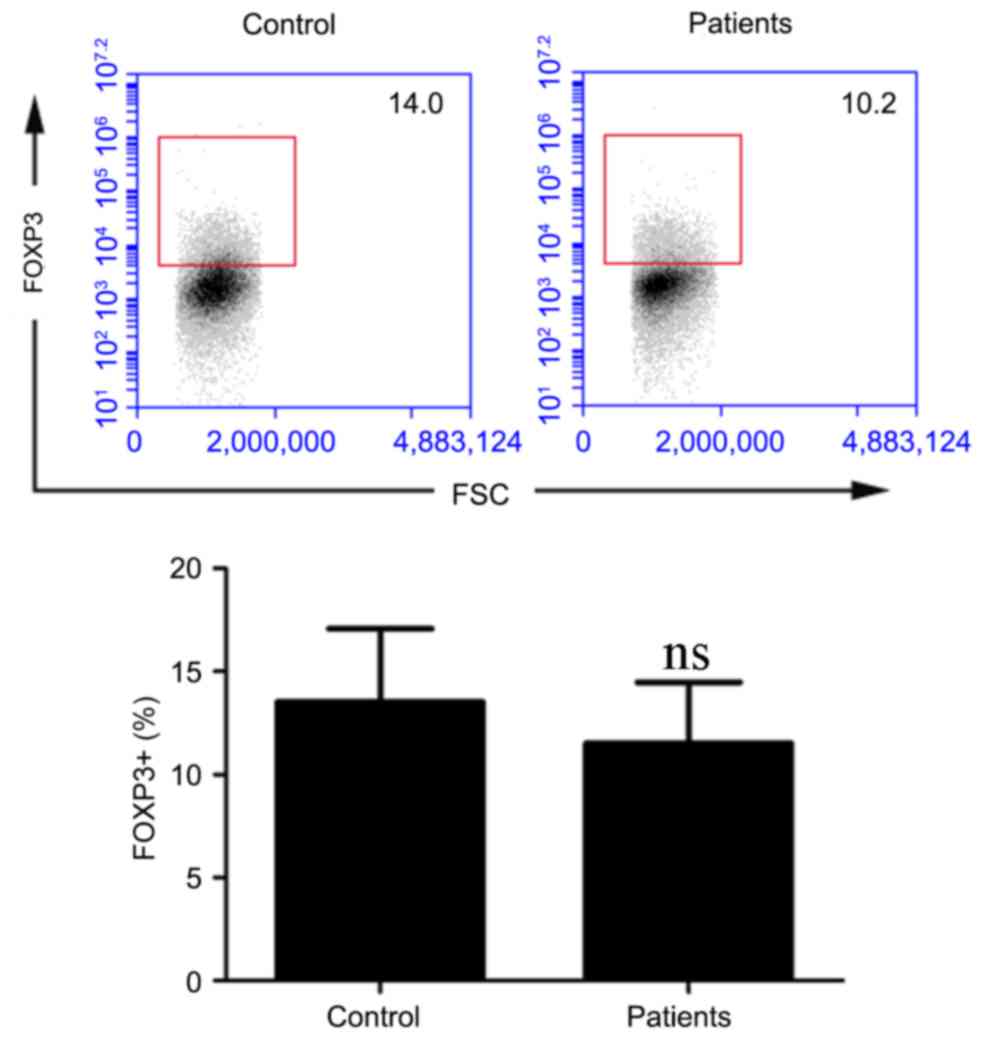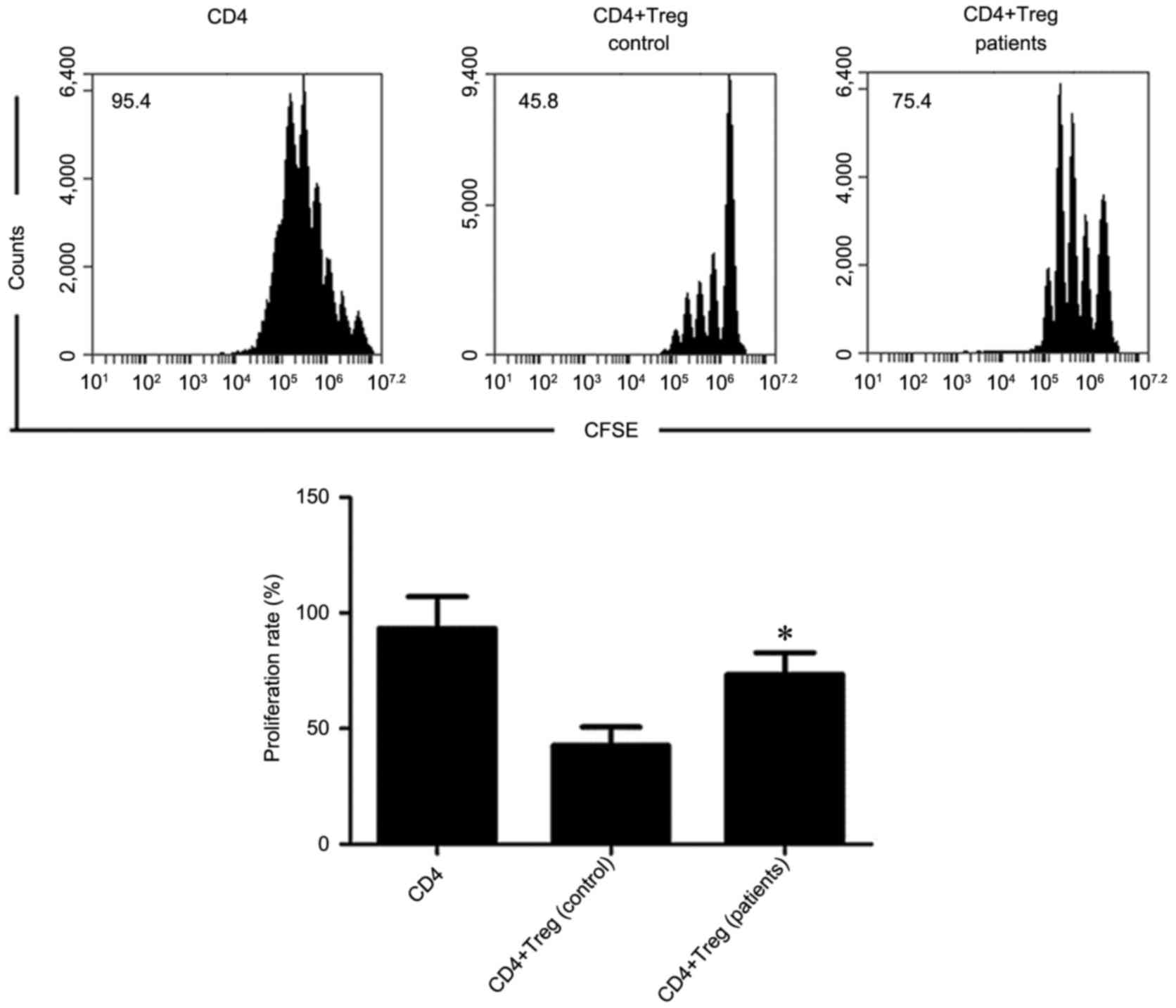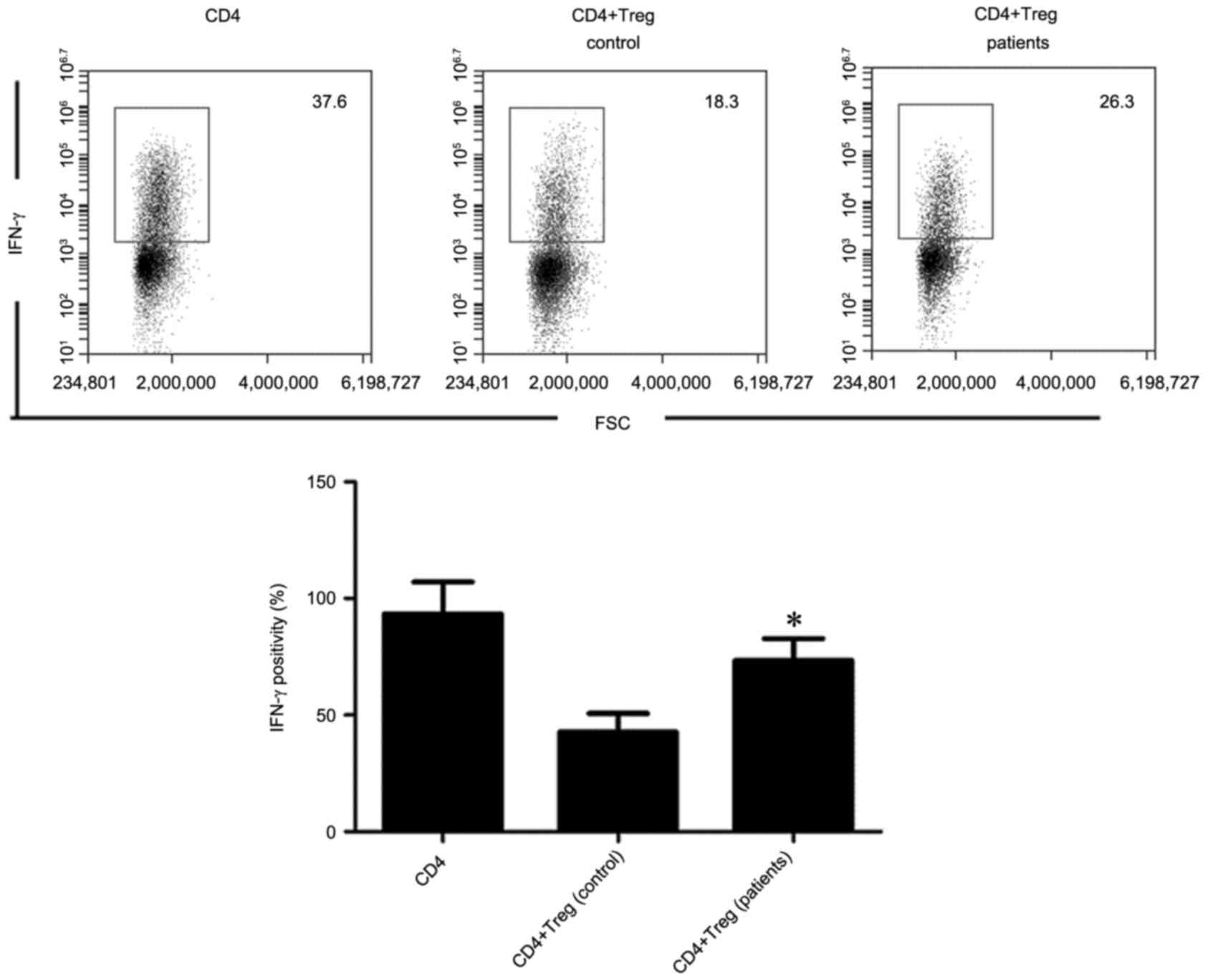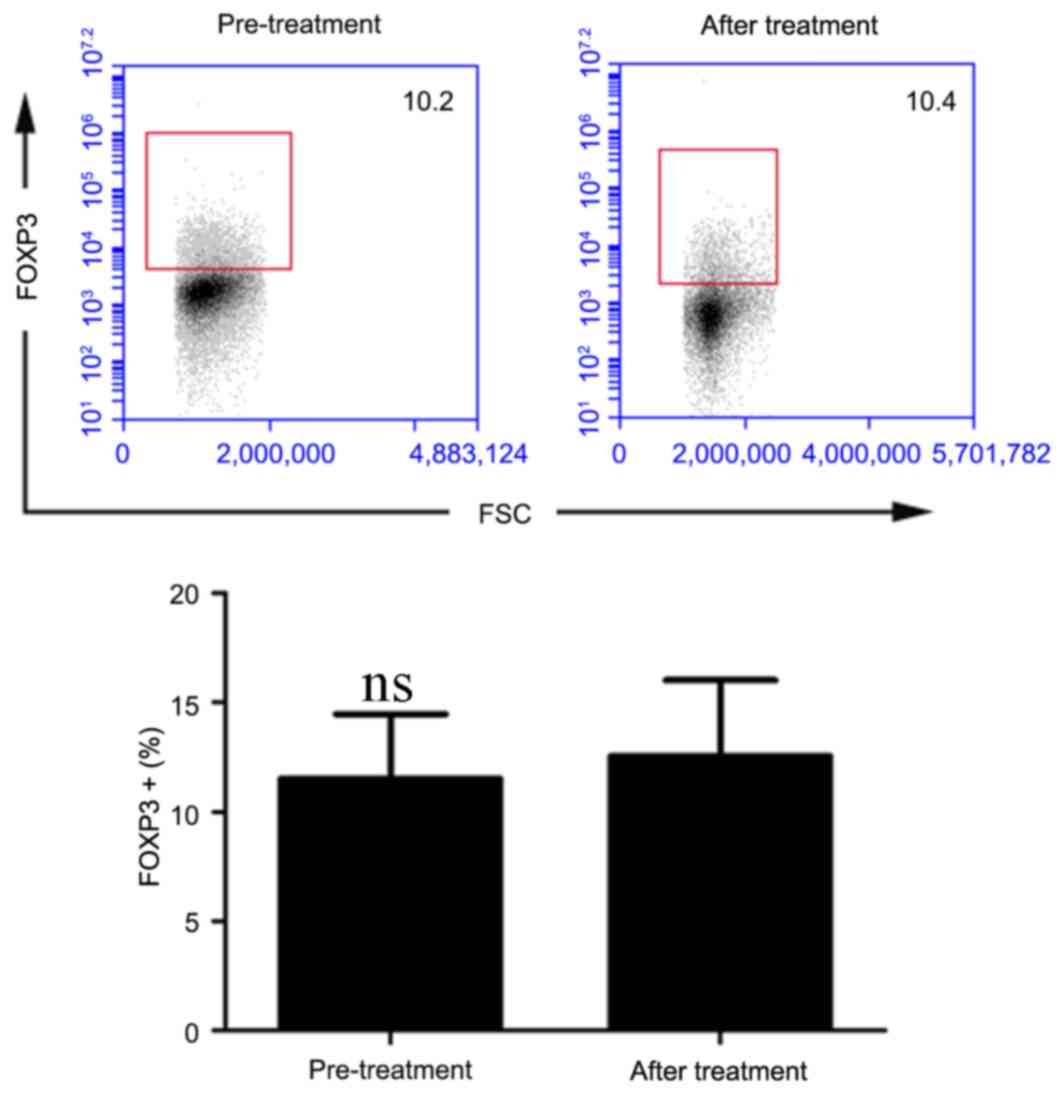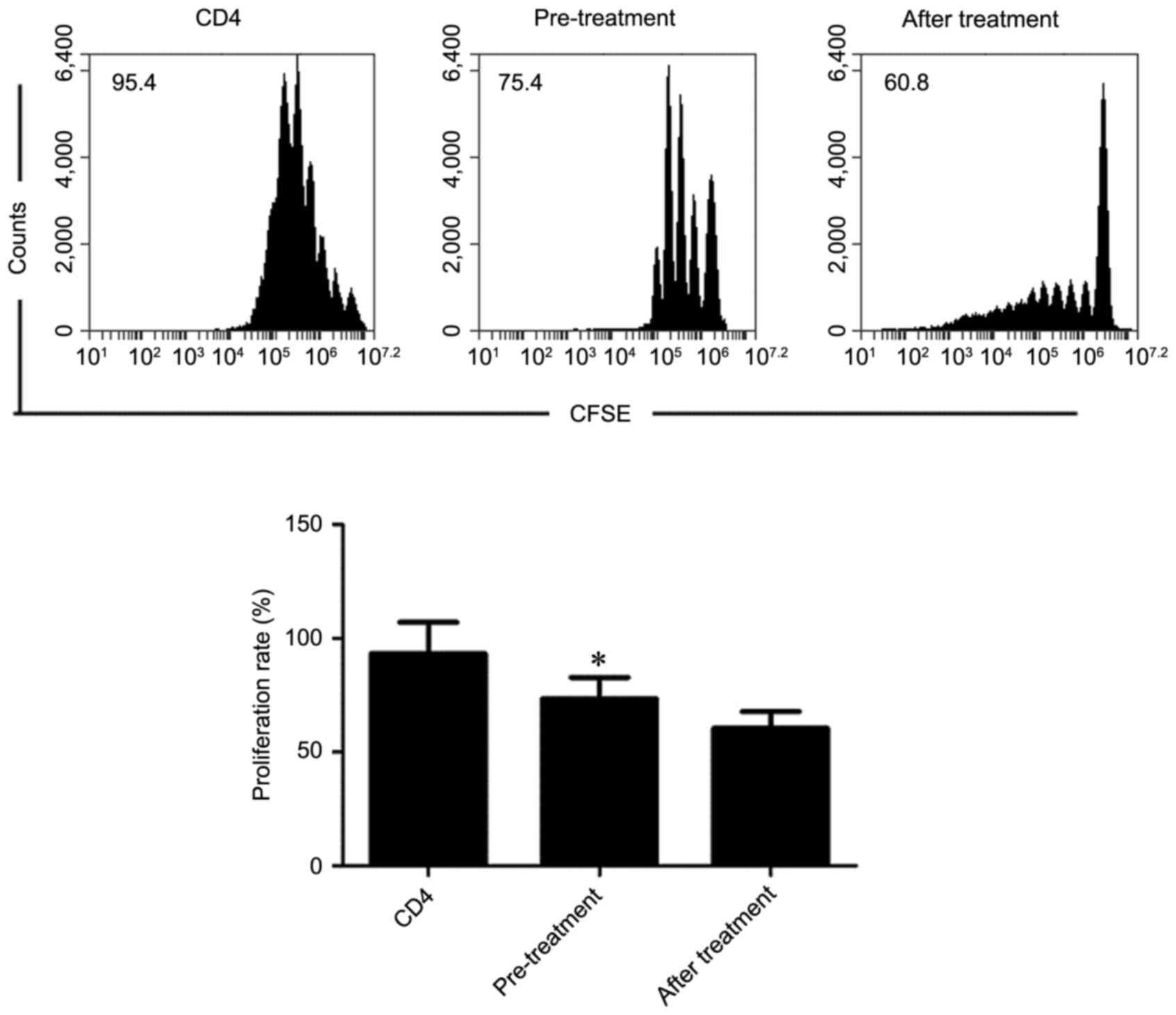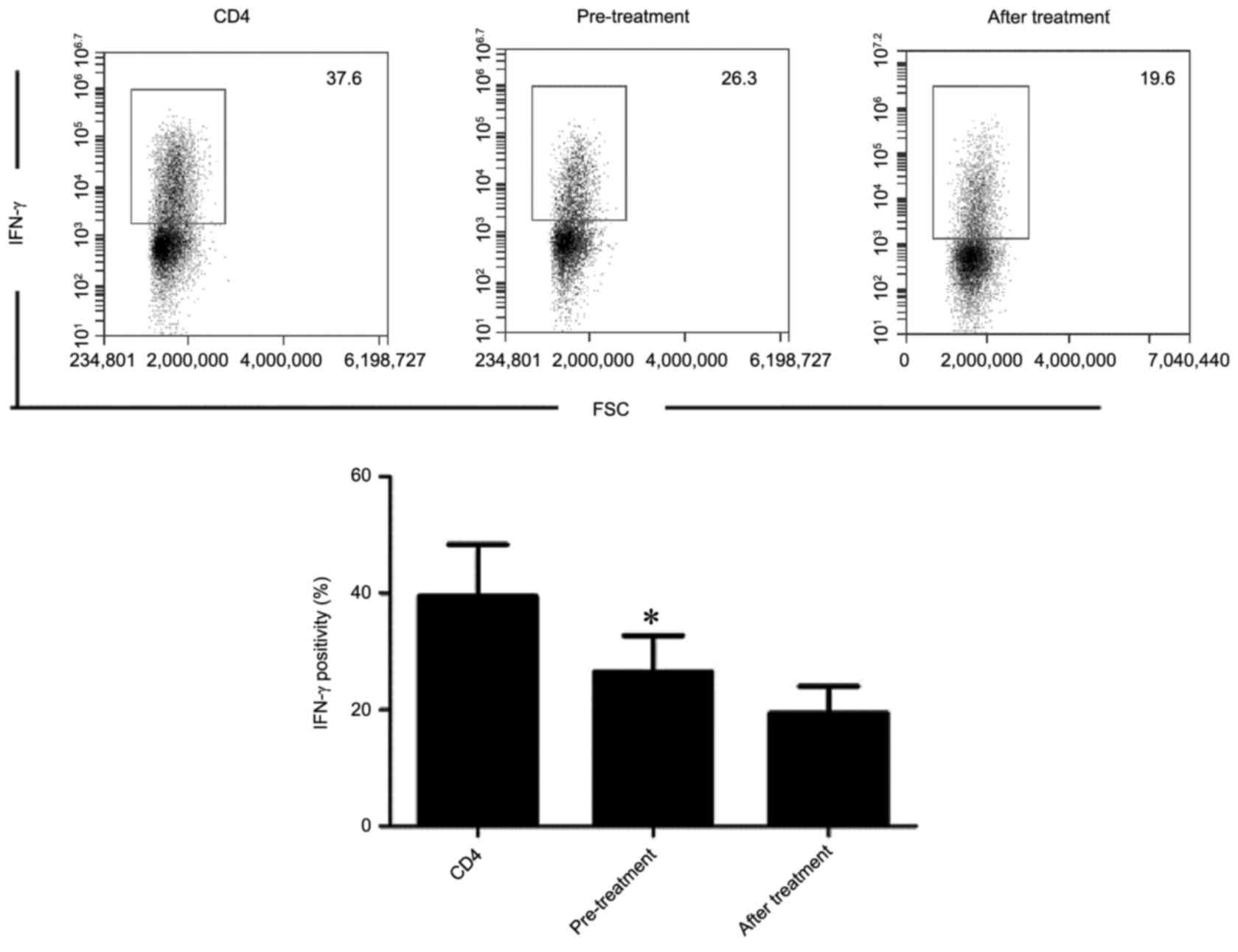Percentage and function of CD4+CD25+ regulatory T cells in patients with hyperthyroidism
- Authors:
- Published online on: November 27, 2017 https://doi.org/10.3892/mmr.2017.8154
- Pages: 2137-2144
-
Copyright: © Jiang et al. This is an open access article distributed under the terms of Creative Commons Attribution License.
Abstract
Introduction
Hyperthyroidism is the most common organ-specific autoimmune disease and the most important reason for Graves' ophthalmopathy. The predominant manifestations of the disease include diffuse goiter, disappeared immune tolerance to thyroid antigens and infiltration of thyroid tissues by lymphocytes. The prevalence of hyperthyroidism accounts for 2% of people worldwide, 5–10 fold higher in females than in males (1). To date, the pathogenesis of hyperthyroidism has not been fully established. It is known that it may be correlated with fever, insufficient sleep, increased psychological burden and other factors, although the pathogenesis for the majority of patients in the clinical setting remains unknown.
Regulatory T cells (Tregs) are a subtype of CD4 T cells characterized by the expression of CD25, while expression of the forkhead box P3 (FOXP3) molecule is a typical marker of Tregs (2). Tregs account for approximately 5–10% of peripheral blood (PB) CD4 T cells. Tregs include two subtypes: Natural Tregs (nTregs; primarily refers to Tregs formed in the embryo/newborn thymus, also described as thymus Tregs or tTregs); and inducible Tregs (iTregs; predominantly induced in vitro, also termed PB Tregs or pTregs) (3). Recent studies indicated that CD4+CD25+ Tregs were significant in various types of autoimmune disease (4,5), and CD4+CD25+ Treg abnormalities may contribute to the occurrence and progression of hyperthyroidism (6). Previous studies demonstrated that, after CD4+CD25+ Tregs were removed from a C57BL/6 mouse, the C57BL/6 mice were more prone to hyperthyroidism (7,8). However, the exact action of CD4+CD25+ Tregs in hyperthyroidism remains unknown, and previous studies primarily focus on investigating the changes in the percentage of CD4+CD25+ Tregs in the PB of patients with hyperthyroidism. One study indicated that the percentage of CD4+CD25+ Tregs in PB was decreased in patients with hyperthyroidism (9), while another study demonstrated that no significant percentage alterations were observed (10).
Therefore, in order to further identify the actions of CD4+CD25+ Tregs in cases of hyperthyroidism, the present study investigated the percentage of CD4+CD25+ Tregs in the PB of patients with hyperthyroidism and its influence on the proliferation of naïve CD4 T cells. In addition, the percentage of PB CD4+CD25+ Tregs in patients with hyperthyroidism following treatment and its influence on naïve CD4T cells was investigated. Furthermore, in-depth analysis and discussion were made on the action mechanism of CD4+CD25+ Tregs in hyperthyroidism.
Materials and methods
Clinical data collection
A total of 60 patients diagnosed with hyperthyroidism at The Fourth Clinical Medical College of Harbin Medical University (Harbin, China) between August 2014 and December 2014 were recruited along with 60 healthy subjects at the same time (age, 18–80 years old for controls and patients; with a 1:1 male:female). Peripheral blood (10 ml) was extracted from the hyperthyroidism patients and healthy control subjects in the morning for subsequent experiments. The diagnostic criteria or the patients with hyperthyroidism were as previously described (11). The inclusion criteria were as follows: Patients diagnosed with hyperthyroidism who had not received anti-thyroid medication and were aged 20–60 years-old. Patients with recurrent hyperthyroidism, abnormal liver and renal function, and those exhibiting complications, such as tumors or heart disease were excluded. Written informed consent was obtained from all participants included in the present study. The present study was approved by the Medical Ethics committee of The Fourth Affiliated Hospital of Harbin Medical University (Harbin, China).
Separation method for PB mononuclear cells (PBMCs)
Blood was samples were taken with sterile sodium citrate as an anticoagulant (10 ml; BD Biosciences, Franklin Lakes, NJ, USA) from the patients with hyperthyroidism and the healthy control subjects and diluted using sterile phosphate-buffered saline (PBS; ratio of 1:1). The diluted blood samples with sodium citrate anticoagulant was added into a 15-ml centrifugation tube containing lymphocyte separation medium (ratio, 2:1 of sodium citrate anticoagulant diluted blood:lymphocyte separation medium), and 800 × g solution was taken to be centrifuged for 18 min at 4°C. PBMCs were collected from the buffy coat, which was added to a 15 ml centrifuge tube containing RPMI-1640 medium (Gibco; Thermo Fisher Scientific, Inc., Waltham, MA, USA) and then 600 × g at 4°C solution was centrifuged for 15 min at 4°C. Cell deposits were resuspended in 10 ml RPMI-1640 medium and 400 × g solution was centrifuged for 8 min at 4°C. Subsequently, 1 ml RPMI-1640 complete medium containing 10% fetal bovine serum (FBS; Hyclone; GE Healthcare Life Sciences, Logan, UT, USA) was used to resuspend the cell deposits, and the cell suspension was prepared to reach a concentration of 2×106 cells/ml for subsequent experiments following 0.16% Trypan blue staining (for 3 min at room temperature). The cells were counted by Olympus light microscope (Olympus Corporation, Tokyo, Japan). The living cells were stained.
Determination of the percentage of CD4+CD25+ Tregs in PB
The Pecp5.5-CD3, PE-CD4, FITC-CD25 and APC-FOXP3 fluorescent antibody combination was used to determine the percentage of CD4+CD25+ Tregs in the PB of patients with hyperthyroidism and the healthy control subjects. All antibodies were purchased from BD Biosciences. PBMCs were obtained from hyperthyroidism patients and healthy control subjects via sterile separation and washed twice using PBS containing 1% bovine serum albumin (BSA; Hyclone; GE Healthcare Life Sciences). The corresponding fluorescent antibodies were added Pecp5.5-CD3 (1:100; cat. no. MCA463PECY5.5), PE-CD4 (1:100; cat. no. MA5-17451) and FITC-CD25 (1:100, cat. no. 302604) and incubated at 4°C for 30 min in the dark, and washed once with PBS containing 1% BSA. All of antibodies were purchased from BD PharMingen; BD Biosciences. Subsequently, the cell permeabilization solution (0.2 mg/ml) was used to wash the cells once. Fixation and permeabilization buffer (eBioscience; Thermo Fisher Scientific, Inc.; 0.5 ml) was added and incubated at room temperature for 30 min in the dark, and corresponding fluorescent antibodies (APC-FOXP3) were added and incubated at room temperature for 30 min in the dark. Cell permeabilization solution was used to wash the cells twice, and cells were resuspended in 1% paraformaldehyde fixed solution (0.1 ml) for detection by flow cytometry. During data analysis done by FlowJo software v10.0.6 (FlowJo LLC, Ashland, OR, USA), CD3 side-scatter was selected, and double-positive CD4 and CD25 cells were subsequently selected in the CD3 cell door to further analyze the expression levels of FOXP3 in the CD4 and CD25 double-positive cells.
Sorting method for naïve CD4 T cells
The PBMCs obtained by the above-mentioned sorting method were separated by magnetic beads (Thermo Fisher Scientific, Inc.) according to the manufacturer's protocol, to obtain the naïve CD4 T cells. The specific procedure was performed as previously described (12).
Determination on the proliferation of naïve CD4 T cells using the carboxyfluorescein succinimidyl ester (CFSE) method
Naïve CD4 T cells (2×106 cells/ml) were washed once with 10 ml RPMI-1640 medium concentrate, and pre-set CFSE dye solution (Invitrogen; Thermo Fisher Scientific, Inc.) was added to a final concentration of 5 mmol/l, and incubated in a 5% CO2 incubator for 10 min at 37°C in the dark. Immediately, 5 ml pre-cooled RPMI-1640 medium containing 5% FBS was added to the cells to terminate staining. Thereafter, 10 ml solution was taken to be centrifuged (400 × g) at 4°C for 8 min, and rinsed with 10 ml RPMI-1640 medium. After 2×106 cells/ml naïve CD4 T cells were resuspended using RPMI-1640 complete medium (RPMI-1640 medium containing 10% FBS), the suspension was added to a 48-well plate coated with 1 g/ml CD3 antibody (cat. no. FR866; DAKO; Agilent Technologies, Inc., Santa Clara, CA, USA) and 2 g/ml CD 28 antibody (cat. no. R716401-8; DAKO; Agilent Technologies, Inc.; placed in 5% CO2 incubator at 37°C for 2 h), and incubated at 37°C for 5 days. Subsequently, cells were collected for detection by flow cytometry. Data were collected on a FACScan flow cytometer (BD Biosciences) and analyzed using FlowJo software version 10.6.0 from FlowJo LLC (Ashland, OR, USA). When inhibition of the proliferation of naïve CD4 T cells of CD4+CD25+ Tregs was detected, two types of cells were added to a 48-well plate coated with 1 g/ml CD3 antibody and 2 g/ml CD 28 antibody (ratio, 1:1), and incubated in a 5% CO2 incubator for 5 days at 37°C. The cells were then collected for detection by flow cytometry.
Detection method for intracellular interferon (IFN)-γ
PBMCs obtained from sterile sorting were placed into a 48-well plate coated with 1 g/ml CD3 antibody and 2 g/ml CD 28 antibody, and incubated in a 5% CO2 incubator for 72 h at 37°C. The PBMCs were placed in a 24-well plate, and exposed to 100 ng/ml propylene glycol monomethyl ether acetate (Sigma-Aldrich; Merck KGaA, Darmstadt, Germany) and 1 µg/ml ionomycin for 1 h. Golgi blockers were added for continuous incubation for 5 h at 37°C. Cells were collected and the surface molecule, CD4 of the dead and swollen cells was stained with trypan blue at the room temperature for 5 min, and 0.5 ml cell membrane fixation/permeabilization buffer was added to resuspend the cells, which were then maintained at room temperature for 30 min in the dark. Permeabilization solution was used to rinse the cells twice, then fluorescent antibody, IFN-γ (cat. no. ab119140; Abcam, Cambridge, MA, USA) was added and the cells were placed at room temperature for 30 min in the dark. Permeabilization solution was used to rinse the cells twice, and cells were resuspended in 1% paraformaldehyde fixed solution (0.2 ml) for detection by flow cytometry. When inhibition of the cytokine secretion capacity of CD4 T cells of CD4+CD25+ Tregs was detected, two types of cells were added to a 48-well plate coated with 1 g/ml CD3 antibody and 2 g/ml CD 28 antibody (ratio, 1:1), and incubated in a 5% CO2 incubator for 72 h at 37°C.
Drug therapeutic strategies for patients with hyperthyroidism
Methimazole (Merck KGaA) combined with levothyrocine (Merck KGaA) was administered to patients with hyperthyroidism for a treatment course of one year. Blood samples and computed tomography scans were use to examine the three types of free thyroid function (T3, T4 and TSH levels), thyroid antibodies (TSH receptor antibodies, thyroid peroxidase antibody and thyroglobulin autoantibodies) and thyroid volume, respectively to determine the remission of the patients' conditions.
Statistical analysis
GraphPad Prism software (version 5; GraphPad Software, Inc., La Jolla, CA, USA) was used for data analysis. Data comparison between the two groups was performed using a paired Student's t test. For comparisons between multiple groups, a one-way analysis of variance test was performed and then a Student-Newman-Keuls post-hoc test was performed. P<0.05 was considered to indicate a statistically significant difference.
Results
Determination on the percentage of CD4+CD25+ Tregs in PB
As exhibited in Fig. 1, the percentage of CD4+CD25+ Tregs in PB was 13.52±3.56% for healthy subjects, and the proportion of CD4+CD25+ Tregs in PB was 11.53±2.94% for patients with hyperthyroidism; the difference was not statistically significant (P>0.05).
Influence of CD4+CD25+ Tregs on the proliferation of naïve CD4 T cells
As exhibited in Fig. 2, the proliferation capacity of naïve CD4 T cells independently cultured was 93.25±13.83%. Following incubation of CD4+CD25+ Tregs and naïve CD4 T cells from PB of healthy control subjects; the proliferation capacity of naïve CD4 T cells was 42.63±8.03%. Following incubation of CD4+CD25+ Tregs and naïve CD4 T cells from PB of patients with hyperthyroidism, the proliferation capacity of the naïve CD4 T cells was 73.42±9.46%. The results indicated that CD4+CD25+ Tregs from the PB of healthy control subjects and patients with hyperthyroidism could significantly inhibit the proliferation capacity of naïve CD4 T cells. However, compared with the inhibitory capacity of CD4+CD25+ Tregs in the PB of healthy control subjects, CD4+CD25+ Tregs of patients with hyperthyroidism exhibited a decreased inhibitory effect on the proliferation of naïve CD4 T cells (P<0.05).
Inhibition of the secretion of cytokines of CD4 T cells by CD4+CD25+ Tregs
As shown in Fig. 3, after IFN-γ+ CD4 T cells in PB were co-incubated with CD4+CD25+ Tregs for healthy control subjects, the percentage of IFN-γ+ CD4 T cells in PB was decreased to 17.26±5.83% from 39.46±8.93%, compared with that of patients with hyperthyroidism, which decreased to 26.47±6.25% from 39.46±8.93%. The results indicated that CD4+CD25+ Tregs in the PB of healthy control subjects and patients with hyperthyroidism significantly inhibited the cytokine secretion capacity of CD4 T cells. However, compared with the cytokine secretion capacity of CD4+CD25+ Tregs of CD4 T cells in the PB of healthy control subjects, the CD4+CD25+ Tregs of patients with hyperthyroidism exhibited a decreased inhibitory effect on the cytokine secretion of CD4 T cells (P<0.05).
Evaluation of the curative effect of medication
After patients with hyperthyroidism were administered with methimazole combined with levothyrocine for 12 months, their conditions were significantly improved (Table I; P<0.05).
Table I.Evaluation of the curative effect of medication on free thyroid function, thyroid antibody and thyroid volume. |
Determination of the percentage of CD4+CD25+ Tregs in the PB of hyperthyroidism patients that underwent treatment
As shown in Fig. 4, the percentage of CD4+CD25+ Tregs in the PB of patients with hyperthyroidism prior to treatment was 11.53±2.94%, compared with 12.56±3.46% following treatment. The difference was not statistically significant (P>0.05).
Influence of CD4+CD25+ Tregs in the PB of treated hyperthyroidism patients on the proliferation of naïve CD4 T cells
As exhibited in Fig. 5, following PB CD4+CD25+ Tregs were co-incubated with naïve CD4 T cells from patients with hyperthyroidism before treatment, the proliferation capacity of naïve CD4 T cells was 73.42±9.46%, compared with 60.45±7.42% following treatment. The results indicated that CD4+CD25+ Tregs in PB of healthy control subjects and patients with hyperthyroidism significantly inhibited the proliferation capacity of naïve CD4 T cells. However, compared with the inhibitory capacity of CD4+CD25+ Tregs in the PB of healthy control subjects, CD4+CD25+ Tregs of patients with hyperthyroidism exhibited increased inhibition on the proliferation of naïve CD4 T cells (P<0.05).
Inhibition of the secretion of cytokines of CD4 T cells by PB CD4+CD25+ Tregs of patients with hyperthyroidism following treatment
As exhibited in Fig. 6, for healthy control subjects, the percentage of PB IFN-γ+ CD4 T cells was 39.46±8.93%. For patients with hyperthyroidism, the percentage of PB IFN-γ+ CD4 T cells was 26.47±6.25% before treatment. After PB IFN-γ+ CD4 T cells were co-incubated with CD4+CD25+ Tregs, the percentage of PB IFN-γ+ CD4 T cells was 19.43±4.61%. The results indicated that CD4+CD25+ Tregs in the PB of patients with hyperthyroidism before and after treatment significantly inhibited the secretion of CD4 T cell cytokines. Compared with the inhibition of cytokine secretion of CD4 T cells by CD4+CD25+ Tregs in the PB of patients with hyperthyroidism prior to treatment, CD4+CD25+ Tregs in the PB of patients with hyperthyroidism exhibited increased inhibition of CD4 T cell cytokine secretion following treatment (P<0.05).
Discussion
Hyperthyroidism is the most common organ-specific autoimmune disease and the most important reason for Graves' ophthalmopathy (13–15). Although the pathogenesis of hyperthyroidism has not been completely elucidated, recent studies indicated that the change of immunologic function may be closely correlated with the occurrence of hyperthyroidism (16,17). The maintenance of immune function is closely associated with immunosuppressive cells existing in the body. Major cells with immunosuppressive functions in the body include CD4 Treg, regulatory B cells, regulatory DC cells and V1 T cells (18–20). The present study investigated the percentage of CD4+CD25+ Tregs in the PB of patients with hyperthyroidism and changes of CD4+CD25+ Treg function. The results demonstrated that compared with the percentage of PB CD4+CD25+ Tregs in healthy control subjects, no significant percentage changes were observed for PB CD4+CD25+ Tregs in patients with hyperthyroidism (P>0.05). Such results were consistent with results of a previous study (10). However, compared with the percentage of CD4+CD25+ Tregs in the PB of healthy control subjects, there are certain studies that report a decreased percentage of PB CD4+CD25+ Tregs in patients with hyperthyroidism (10). It is proposed that the differing study results are caused by various detection methods and staining technologies. The current study further detected CD4+CD25+ Treg cell functions in the PB of patients with hyperthyroidism, and the result indicated that the immunosuppressive functions of PB CD4+CD25+ Tregs were decreased in the patients with hyperthyroidism. PB CD4+CD25+ Tregs inhibited the proliferation of naïve CD4 T cells and significantly decreased the secretion of CD4 T cell cytokines in patients with hyperthyroidism (P<0.05). This result indicated that the PB CD4+CD25+ Treg immunosuppression function was decreased in patients with hyperthyroidism and the non-proportional decrease may be closely associated with the occurrence and progression of hyperthyroidism. Although it remains unknown as to whether there is a decrease in the immunosuppressive functions of PB CD4+CD25+ Tregs in patients with hyperthyroidism, previous studies demonstrated that C57BL/6 mice were more prone to hyperthyroidism after CD4+CD25+ Tregs were removed from the C57BL/6 mice (7,8). This further indicates that CD4+CD25+ Tregs are important in the occurrence and progression of hyperthyroidism.
Although factors causing a decrease in immunosuppressive functions of PB CD4+CD25+ Tregs remain unknown in patients with hyperthyroidism, the results of the present study and associated studies indicate that the decrease in the immunosuppressive functions of PB CD4+CD25+ Tregs may be closely correlated with the occurrence and progression of hyperthyroidism. Therefore, improving the immunosuppressive functions of PB CD4+CD25+ Tregs via surgery may be an effective therapeutic strategy to treat hyperthyroidism. Hu et al (6) reported that dexamethasone exerted positive effects in hyperthyroidism (6) and may improve the immunosuppressive function of CD4+CD25+ Tregs (21). In addition, Klatka et al (3) reported that methimazole may be administered to pediatric patients with hyperthyroidism and acts by regulating the function of Tregs. In the present study, methimazole combined with levothyrocine was administered to patients with hyperthyroidism over the course of one year. It was found that conditions of patients with hyperthyroidism were significantly improved (P<0.05) subsequent to this drug therapy. Compared with the percentage of PB CD4+CD25+ Tregs in the patients with hyperthyroidism before treatment, no significant changes were observed in the percentage of PB CD4+CD25+ Tregs cells following treatment (P>0.05). For patients with hyperthyroidism subsequent to treatment, CD4+CD25+ Tregs exhibited significantly reduced inhibition of naïve CD4T cell proliferation and increased secretion capacity of CD4 T cell cytokines, compared with those of the patients with hyperthyroidism before treatment (P<0.05). Such results further demonstrate that improving the immunosuppressive function of PB CD4+CD25+ Tregs is an effective method for treating patients with hyperthyroidism.
There are several limitations in the present study. First, the sample size was limited and the results need to be confirmed. Second, the present study was only conducted using patient samples; further work with animal model is likely to be the most effective approach for understanding the mechanisms.
In conclusion, the current study indicates that CD4+CD25+ Treg function was decreased in patients with hyperthyroidism, and the non-proportional decrease may be closely associated with the occurrence and progression of hyperthyroidism.
References
|
Vanderpump MPJ: The epidemiology of thyroid disease. Br Med Bull. 99:39–51. 2011. View Article : Google Scholar : PubMed/NCBI | |
|
Mao C, Wang S, Xiao Y, Xu J, Jiang Q, Jin M, Jiang X, Guo H, Ning G and Zhang Y: Impairment of regulatory capacity of CD4+CD25+ regulatory T cells mediated by dendritic cell polarization and hyperthyroidism in Graves' disease. J Immunol. 186:4734–4743. 2011. View Article : Google Scholar : PubMed/NCBI | |
|
Klatka M, Kaszubowska L, Grywalska E, Wasiak M, Szewczyk L, Foerster J, Cyman M and Rolinski J: Treatment of Graves' disease with methimazole in children alters the proliferation of Treg cells and CD3+ T lymphocytes. Folia Histochem Cytobiol. 52:69–77. 2014. View Article : Google Scholar : PubMed/NCBI | |
|
Hamari S, Kirveskoski T, Glumoff V, Kulmala P, Simell O, Knip M and Veijola R: Analyses of regulatory CD4+ CD25+ FOXP3+ T cells and observations from peripheral T cell subpopulation markers during the development of type 1 diabetes in children. Scand J Immunol. 83:279–287. 2016. View Article : Google Scholar : PubMed/NCBI | |
|
Legorreta-Haquet MV, Chávez-Rueda K, Chávez-Sánchez L, Cervera-Castillo H, Zenteno-Galindo E, Barile-Fabris L, Burgos-Vargas R, Álvarez-Hernández E and Blanco-Favela F: Function of treg cells decreased in patients with systemic lupus erythematosus due to the effect of prolactin. Medicine (Baltimore). 95:e23842016. View Article : Google Scholar : PubMed/NCBI | |
|
Hu Y, Tian W, Zhang LL, Liu H, Yin GP, He BS and Mao XM: Function of regulatory T-cells improved by dexamethasone in Graves' disease. Eur J Endocrinol. 166:641–646. 2012. View Article : Google Scholar : PubMed/NCBI | |
|
Saitoh O and Nagayama Y: Regulation of Graves' hyperthyroidism with naturally occurring CD4+CD25+ regulatory T cells in a mouse model. Endocrinology. 147:2417–2422. 2006. View Article : Google Scholar : PubMed/NCBI | |
|
Nagayama Y, Horie I, Saitoh O, Nakahara M and Abiru N: CD4+CD25+ naturally occurring regulatory T cells and not lymphopenia play a role in the pathogenesis of iodide-induced autoimmune thyroiditis in NOD-H2h4 mice. J Autoimmun. 29:195–202. 2007. View Article : Google Scholar : PubMed/NCBI | |
|
Mao C, Wang S, Xiao Y, Xu J, Jiang Q, Jin M, Jiang X, Guo H, Ning G and Zhang Y: Impairment of regulatory capacity of CD4+ CD25+ regulatory T cells mediated by dendritic cell polarization and hyperthyroidism in Graves' disease. J Immunol. 186:4734–4743. 2011. View Article : Google Scholar : PubMed/NCBI | |
|
He K, Hu Y and Mao X: Abnormal proportions of immune regulatory cells and their subsets in peripheral blood of patients with Graves' disease. Xi Bao Yu Fen Zi Mian Yi Xue Za Zhi. 30:1190–1193. 2014.(In Chinese). PubMed/NCBI | |
|
Lantz M, Calissendorff J, Träisk F, Tallstedt L, Planck T, Törring O, Hallengren B and Åsman P: Adjuvant treatment of graves' disease with diclofenac: Safety, effects on ophthalmopathy and antibody concentrations. Eur Thyroid J. 5:50–56. 2016. View Article : Google Scholar : PubMed/NCBI | |
|
Chen JF, Gao J, Zhang D, Wang ZH and Zhu JY: CD4+Foxp3+ regulatory T cells converted by rapamycin from peripheral CD4+CD25(−) naive T cells display more potent regulatory ability in vitro. Chin Med J (Engl). 123:942–948. 2010.PubMed/NCBI | |
|
Singhal N, Praveen VP, Bhavani N, Menon AS, Menon U, Abraham N, Kumar H, JayKunmar RV, Nair V, Sundaram S and Sundaram P: Technetium uptake predicts remission and relapse in Grave's disease patients on antithyroid drugs for at least 1 year in South Indian subjects. Indian J Endocrinol Metab. 20:157–161. 2016. View Article : Google Scholar : PubMed/NCBI | |
|
Allencherril J and Birnbaum I: Heart failure in thyrotoxic cardiomopathy: Extracorporeal membrane oxygenation treatment for graves' disease. J Extra Corpor Technol. 47:231–232. 2015.PubMed/NCBI | |
|
Kaaroud H, Oueslati I, Harzallah A, Ben Nacef I, Khiari K and Ben Hamida F: Benzylthiouracil induced ANCA associated glomerulonephritis in patients with graves' disease. Tunis Med. 93:696–701. 2015.PubMed/NCBI | |
|
Sasazuki T, Inoko H, Morishima S and Morishima Y: Gene map of the HLA region, graves' disease and hshimoto thyroiditis, and hematopoietic stem cell transplantation. Adv Immunol. 129:175–249. 2016. View Article : Google Scholar : PubMed/NCBI | |
|
Côté-Bigras S, Tran V, Turcotte S, Rola-Pleszczynski M, Verrerult J and Rottembourg D: Impaired immune regulation after radioiodine therapy for Graves' disease and the protective effect of Methimazole. Endocrine. 52:587–596. 2016. View Article : Google Scholar : PubMed/NCBI | |
|
Wei Y, Zheng D, Li X, Zhou W, Qian Y, Ming C and Shi B: Infusion of dendritic cells carrying donor lymphocytes treated with 8-methoxypsoralen and ultraviolet A light induces CD19+IL-10+ regulatory B cells and promotes skin allograft survival. Transplant Proc. 46:pp. 3641–3646. 2014; View Article : Google Scholar : PubMed/NCBI | |
|
Li Q, Guo Z, Xu X, Xia X and Cao X: Pulmonary stromal cells induce the generation of regulatory DC attenuating T-cell-mediated lung inflammation. Eur J Immunol. 38:2751–2761. 2008. View Article : Google Scholar : PubMed/NCBI | |
|
Peng G, Wang HY, Peng W, Kiniwa Y, Seo KH and Wang RF: Tumor-infiltrating gammadelta T cells suppress T and dendritic cell function via mechanisms controlled by a unique toll-like receptor signaling pathway. Immunity. 27:334–348. 2007. View Article : Google Scholar : PubMed/NCBI | |
|
Mao XM, Li HQ, Li Q, Li DM, Xie XJ, Yin GP, Zhang P, Xu XH, Wu JD, Chen SW and Wang SK: Prevention of relapse of Graves' disease by treatment with an intrathyroid injection of dexamethasone. J Clin Endocrinol Metab. 94:4984–4991. 2009. View Article : Google Scholar : PubMed/NCBI |



